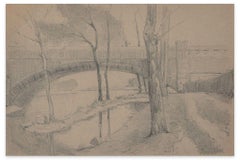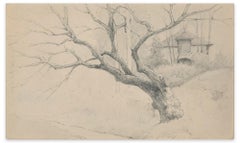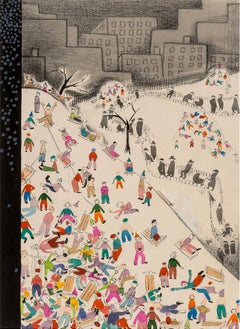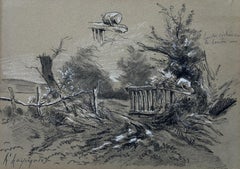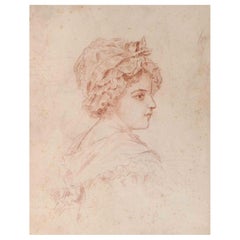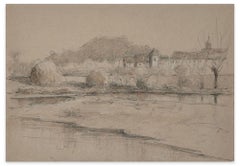Emile-Louis Minet Art
to
2
2
1
1
Bridge on the River - Charcoal and Pencil by E.-L. Minet - 1919
By Emile-Louis Minet
Located in Roma, IT
Bridge on the River is a beautiful drawing in pencil and charcoal realized by the French painter Emile-Louis Minet in 1919. The state of preservation is very good, except for a small...
Category
1910s Naturalistic Emile-Louis Minet Art
Materials
Charcoal, Pencil
Tree and House - Charcoal by E.-L. Minet - Early 1900
By Emile-Louis Minet
Located in Roma, IT
Tree and House is a precious pencil study realized by the French painter Emile-Louis Minet. The state of preservation is excellent. The piece of paper comes from a sketchbook, and it...
Category
Early 1900s Naturalistic Emile-Louis Minet Art
Materials
Charcoal, Pencil
Related Items
Children Snow Sledding in Central Park - New Yorker Cover Study
Located in Miami, FL
Hungarian/American artist/illustrator depicts a charming scene of sledding in the snow in Central Park. The work is abstract in its design as it's functional in its narrative - Unpublished New Yorker...
Category
1940s Modern Emile-Louis Minet Art
Materials
Charcoal, Ink, Watercolor, Gouache, Pencil
$15,000
H 16.85 in W 12.25 in
Henri Harpignies (1819-1916) A Barrier on the hedge, study, signed drawing
By Henri Joseph Harpignies
Located in Paris, FR
Henri Harpignies (1819-1916)
A Barrier on the hedge, study
Signed lower left, annotation "branches séchées sur la barrière" (dried branches on the fence) on the upper right
Charcoal...
Category
1860s Barbizon School Emile-Louis Minet Art
Materials
Chalk, Charcoal
Winter Night in Canmore, black and white charcoal drawing of trees and sky
Located in New York, NY
Charcoal on paper drawing by Toronto-based artist Katherine Curci. Framed.
Katherine Curci began this series of charcoal drawings, premiered in This L...
Category
2010s Contemporary Emile-Louis Minet Art
Materials
Paper, Charcoal
$1,175
H 13.75 in W 17.5 in
Whimsical Illustration Hiking Cartoon, 1938 Mt Tremblant Ski Lodge William Steig
By William Steig (b.1907)
Located in Surfside, FL
Lighthearted Illustration of Outdoor Pursuits This one being cross country hiking signed "W. Steig"
Provenance: from Mrs. Joseph B. Ryan, Commissioned by Joe Ryan for the bar at his ski resort, Mount Tremblant Lodge, in 1938.
Mont Tremblant, P.Q., Canada
Watercolor and ink on illustration board, sights sizes 8 1/2 x 16 1/2 in., framed.
In 1938 Joe Ryan, described as a millionaire from Philadelphia, bushwhacked his way to the summit of Mont Tremblant and was inspired to create a world class ski resort at the site. In 1939 he opened the Mont Tremblant Lodge, which remains part of the Pedestrian Village today. This original illustration is on Whatman Illustration board. the board measures 14 X 22 inches. label from McClees Galleries, Philadelphia, on the frame backing paper.
William Steig, 1907 – 2003 was an American cartoonist, sculptor, and, in his later life, an illustrator and writer of children's books. Best known for the picture books Sylvester and the Magic Pebble, Abel's Island, and Doctor De Soto, he was also the creator of Shrek!, which inspired the film series of the same name. He was the U.S. nominee for both of the biennial, international Hans Christian Andersen Awards, as a children's book illustrator in 1982 and a writer in 1988.
Steig was born in Brooklyn, New York in 1907, and grew up in the Bronx. His parents were Polish-Jewish immigrants from Austria, both socialists. His father, Joseph Steig, was a house painter, and his mother, Laura Ebel Steig, was a seamstress who encouraged his artistic leanings. As a child, he dabbled in painting and was an avid reader of literature. Among other works, he was said to have been especially fascinated by Pinocchio.He graduated from Townsend Harris High School at 15 but never completed college, though he attended three, spending two years at City College of New York, three years at the National Academy of Design and a mere five days at the Yale School of Fine Arts before dropping out of each.
Hailed as the "King of Cartoons" Steig began drawing illustrations and cartoons for The New Yorker in 1930, producing more than 2,600 drawings and 117 covers for the magazine. Steig, later, when he was 61, began writing children's books. In 1968, he wrote his first children's book. He excelled here as well, and his third book, Sylvester and the Magic Pebble (1969), won the Caldecott Medal. He went on to write more than 30 children's books, including the Doctor DeSoto series, and he continued to write into his nineties. Among his other well-known works, the picture book Shrek! (1990) formed the basis for the DreamWorks Animation film Shrek (2001). After the release of Shrek 2 in 2004, Steig became the first sole-creator of an animated movie franchise that went on to generate over $1 billion from theatrical and ancillary markets after only one sequel. Along with Maurice Sendak, Saul Steinberg, Ludwig Bemelmans and Laurent de Brunhofff his is one of those rare cartoonist whose works form part of our collective cultural heritage.
In 1984, Steig's film adaptation of Doctor DeSoto directed by Michael Sporn was nominated for the Academy Award for Best Animated Short Film. As one of the most admired cartoonists of all time, Steig spent seven decades drawing for the New Yorker magazine. He touched generations of readers with his tongue–in–cheek pen–and–ink drawings, which often expressed states of mind like shame, embarrassment or anger. Later in life, Steig turned to children's books, working as both a writer and illustrator.
Steig's children's books were also wildly popular because of the crazy, complicated language he used—words like lunatic, palsied, sequestration, and cleave. Kids love the sound of those words even if they do not quite understand the meaning. Steig's descriptions were also clever. He once described a beached whale as "breaded with sand."
Throughout the course of his career, Steig compiled his cartoons and drawings into books. Some of them were published first in the New Yorker. Others were deemed too dark to be printed there. Most of these collections centered on the cold, dark psychoanalytical truth about relationships. They featured husbands and wives fighting and parents snapping at their kids. His first adult book, Man About Town, was published in 1932, followed by About People, published in 1939, which focused on social outsiders. Sick of Each Other, published in 2000, included a drawing depicting a wife holding her husband at gunpoint, saying, "Say you adore me."
According to the Los Angeles Times, fellow New Yorker artist Edward Sorel...
Category
1930s Naturalistic Emile-Louis Minet Art
Materials
Archival Ink, Watercolor, Illustration Board
Birch Mystery, trees, female figure, neutral tones, collage on archival paper
By Audrey Anastasi
Located in Brooklyn, NY
Paper paint charcoal collage
Paper charcoal collage
These collages were created first in the presence of a live model, working quickly, in charcoal and again, later, alone in the stu...
Category
2010s Surrealist Emile-Louis Minet Art
Materials
Charcoal, Archival Paper, Acrylic, Mixed Media
$1,200
H 22.5 in W 28.5 in D 0.2 in
Whimsical Illustration Skiing Cartoon, 1938 Mt Tremblant Ski Lodge William Steig
By William Steig (b.1907)
Located in Surfside, FL
Lighthearted Illustration of Outdoor Pursuits This one being a Skiing scene, a boy and a girl on skis. signed W. Steig
Provenance: from Mrs. Joseph B. Ryan, Commissioned by Joe Ryan for the bar at his ski resort, Mount Tremblant Lodge, in 1938.
Mont Tremblant, P.Q., Canada
Watercolor and ink on illustration board, sights sizes 8 1/2 x 16 1/2 in., framed.
In 1938 Joe Ryan, described as a millionaire from Philadelphia, bushwhacked his way to the summit of Mont Tremblant and was inspired to create a world class ski resort at the site. In 1939 he opened the Mont Tremblant Lodge, which remains part of the Pedestrian Village today. This original illustration is on Whatman Illustration board. the board measures 14 X 22 inches. label from McClees Galleries, Philadelphia, on the frame backing paper.
William Steig, 1907 – 2003 was an American cartoonist, sculptor, and, in his later life, an illustrator and writer of children's books. Best known for the picture books Sylvester and the Magic Pebble, Abel's Island, and Doctor De Soto, he was also the creator of Shrek!, which inspired the film series of the same name. He was the U.S. nominee for both of the biennial, international Hans Christian Andersen Awards, as a children's book illustrator in 1982 and a writer in 1988.
Steig was born in Brooklyn, New York in 1907, and grew up in the Bronx. His parents were Polish-Jewish immigrants from Austria, both socialists. His father, Joseph Steig, was a house painter, and his mother, Laura Ebel Steig, was a seamstress who encouraged his artistic leanings. As a child, he dabbled in painting and was an avid reader of literature. Among other works, he was said to have been especially fascinated by Pinocchio.He graduated from Townsend Harris High School at 15 but never completed college, though he attended three, spending two years at City College of New York, three years at the National Academy of Design and a mere five days at the Yale School of Fine Arts before dropping out of each.
Hailed as the "King of Cartoons" Steig began drawing illustrations and cartoons for The New Yorker in 1930, producing more than 2,600 drawings and 117 covers for the magazine. Steig, later, when he was 61, began writing children's books. In 1968, he wrote his first children's book. He excelled here as well, and his third book, Sylvester and the Magic Pebble (1969), won the Caldecott Medal. He went on to write more than 30 children's books, including the Doctor DeSoto series, and he continued to write into his nineties. Among his other well-known works, the picture book Shrek! (1990) formed the basis for the DreamWorks Animation film Shrek (2001). After the release of Shrek 2 in 2004, Steig became the first sole-creator of an animated movie franchise that went on to generate over $1 billion from theatrical and ancillary markets after only one sequel. Along with Maurice Sendak, Saul Steinberg, Ludwig Bemelmans and Laurent de Brunhofff his is one of those rare cartoonist whose works form part of our collective cultural heritage.
In 1984, Steig's film adaptation of Doctor DeSoto directed by Michael Sporn was nominated for the Academy Award for Best Animated Short Film. As one of the most admired cartoonists of all time, Steig spent seven decades drawing for the New Yorker magazine. He touched generations of readers with his tongue–in–cheek pen–and–ink drawings, which often expressed states of mind like shame, embarrassment or anger. Later in life, Steig turned to children's books, working as both a writer and illustrator.
Steig's children's books were also wildly popular because of the crazy, complicated language he used—words like lunatic, palsied, sequestration, and cleave. Kids love the sound of those words even if they do not quite understand the meaning. Steig's descriptions were also clever. He once described a beached whale as "breaded with sand."
Throughout the course of his career, Steig compiled his cartoons and drawings into books. Some of them were published first in the New Yorker. Others were deemed too dark to be printed there. Most of these collections centered on the cold, dark psychoanalytical truth about relationships. They featured husbands and wives fighting and parents snapping at their kids. His first adult book, Man About Town, was published in 1932, followed by About People, published in 1939, which focused on social outsiders. Sick of Each Other, published in 2000, included a drawing depicting a wife holding her husband at gunpoint, saying, "Say you adore me."
According to the Los Angeles Times, fellow New Yorker artist Edward Sorel...
Category
1930s Naturalistic Emile-Louis Minet Art
Materials
Archival Ink, Watercolor, Illustration Board
Coastal landscape, 1882
Located in PARIS, FR
Frank Charles Peyraud (1858-1948)
Coastal landscape, 1882
Charcoal and shading on paper
Signed "C. Peyraud", dated "82" and dedicated "à l'ami Baradat" ? lower right
29.5 x 56 cm
Slightly oiled
A French-born artist born in Switzerland in 1858, Frank Charles Peyraud showed an early interest in drawing and painting. He grew up in a rural environment before studying architecture at the Swiss Federal Institute of Technology in Zurich, encouraged by his father. In 1877, he entered the École des Beaux-Arts in Paris. In 1881, Frank Peyraud...
Category
1880s Post-Impressionist Emile-Louis Minet Art
Materials
Charcoal
Sunrise at Mount Fuji, black and white charcoal drawing of mountains in Japan
Located in New York, NY
Charcoal on paper drawing by Toronto-based artist Katherine Curci. Unframed.
Katherine Curci began this series of charcoal drawings, premiered in This...
Category
2010s Contemporary Emile-Louis Minet Art
Materials
Paper, Charcoal
America's Cup - 1967. Wing Mark, Intrepid and Dame Pattie.
By Joseph Webster Golinkin
Located in New York, NY
AMERICA'S CUP - 1967. WING MARK. INTREPID - DAME PATTIE [AUS].
This Joseph Webster Golinkin watercolor of the 1967 America's Cup depicts the...
Category
1960s Naturalistic Emile-Louis Minet Art
Materials
Watercolor
$11,250
H 22.25 in W 30.38 in D 0.98 in
Norwegian Pine Grove - The inner glow of the trees -
Located in Berlin, DE
Themistokles von Eckenbrecher (1842 Athens - 1921 Goslar), Norwegian pine grove, 1901. Watercolor on blue-green paper, 30 x 22 cm. Signed, dated and inscribed in his own hand "TvE. Fagermes [i.e. Fagermes]. 26.6.[19]01."
- Slight crease throughout at left margin, otherwise in good condition.
About the artwork
Themistokles von Eckenbrecher often traveled to Norway to study the nature that fascinated him there. On June 26, 1901, near the southern Norwegian town of Fagernes, in the summer evening sun, he saw a small pine grove, which he immediately captured in a watercolor. He exposed the trees growing on a small hill in front of the background, so that the pines completely define the picture and combine to form a tense motif. The tension comes from the contrast of form and color. The trunks, growing upward, form a vertical structure that is horizontally penetrated by the spreading branches and the pine needles, which are rendered as a plane. This structural tension is further intensified by the color contrast between the brown-reddish iridescent trunks and branches and the green-toned needlework.
Themistokles von Eckenbrecher, however, does not use the observed natural scene as an inspiring model for a dance of color and form that detaches itself from the motif and thus treads the path of abstracting modernism. Its inner vitality is to be brought to light and made aesthetically accessible through the work of art.
It is precisely in order to depict the inner vitality of nature that von Eckenbrecher chooses the technique of watercolor, in which the individual details, such as the needles, are not meticulously worked out, but rather a flowing movement is created that unites the contrasts. The trees seem to have formed the twisted trunks out of their own inner strength as they grew, creatingthose tense lineations that the artist has put into the picture. The inner strength continues in the branches and twigs, culminating in the upward growth of the needles. At the same time, the trunks, illuminated by the setting sun, seem to glow from within, adding an almost dramatic dimension to the growing movement.
Through the artwork, nature itself is revealed as art. In order to make nature visible as art in the work, von Eckenbrecher exposes the group of trees so that they are bounded from the outside by an all-encompassing contour line and merge into an areal unity that enters into a figure-ground relationship with the blue-greenish watercolor paper. The figure-ground relationship emphasizes the ornamental quality of the natural work of art, which further enforces the artwork character of the group of trees.
With the presentation of Themistokles von Eckenbrecher's artistic idea and its realization, it has become clear that the present watercolor is not a study of nature in the sense of a visual note by the artist, which might then be integrated into a larger work context, but a completely independent work of art. This is why von Eckenbrecher signed the watercolor. In addition, it is marked with a place and a date, which confirms that this work of nature presented itself to him in exactly this way at this place at this time. At the same time, the date and place make it clear that the natural work of art has been transferred into the sphere of art and thus removed from the time of the place of nature.
About the artist
Themistocles' parents instilled a life of travel in their son, who is said to have spoken eleven languages. His father, who was interested in ancient and oriental culture, was a doctor and had married Francesca Magdalena Danelon, an Italian, daughter of the British consul in Trieste. During a stay in Athens - Gustav von Eckenbrecher was a friend of Heinrich von Schliemann and is said to have given him crucial clues as to the location of Troy - Themistokles saw the light of day in 1842.
After an interlude in Berlin, where Themistokles was educated at the English-American School, the journey began again. From 1850 to 1857 the family lived in Constantinople, after which the father opened a practice in Potsdam, where Themistokles, who wanted to become a painter, was taught by the court painter Carl Gustav Wegener.
In 1861 the von Eckenbrechers left Potsdam and settled in Düsseldorf. There Themistokles received two years of private tuition from Oswald Aschenbach, who greatly admired the talented young artist. After his artistic training, he undertook extensive travels, often accompanied by Prince Peter zu Sayn-Wittgenstein, which took him to northern and eastern Europe, but above all to the Middle East and even to South America. The paintings that resulted from these journeys established his artistic reputation and led to his participation in large panoramas such as the 118 x 15 metre Entry of the Mecca Caravan into Cairo, painted for the City of Hamburg in 1882.
1882 was also the start of a total of 21 study trips to Scandinavia, most of them to Norway, and the unique Norwegian landscape with its rugged fjords became a central motif in his work. Along with Anders Askevold and Adelsteen Normann...
Category
Early 1900s Naturalistic Emile-Louis Minet Art
Materials
Watercolor
$1,148 Sale Price
20% Off
H 11.82 in W 8.67 in
Pio Semeghini (Italian Impressionistic) - Early 20th century landscape painting
Located in Varmo, IT
Pio Semeghini (Quistello 1878 - Verona 1964) - Falzè di Piave.
25.5 x 34.5 cm without frame, 52 x 61 cm with frame.
Charcoal and pastel drawing on paper, within passe-partout in wo...
Category
Early 20th Century Impressionist Emile-Louis Minet Art
Materials
Paper, Charcoal, Pastel
$1,435 Sale Price
33% Off
H 17.52 in W 20.08 in
Les Indestinés, Charcoal, Original Black & White Drawing, Wave, Seascape
Located in AIX-EN-PROVENCE, FR
Work : Original Drawing, Handmade Artwork, Unique Work.
Medium : Charcoal and Graphite on Archival Watercolour paper 300Gsm.
Artist : Fabien Granet
Subject : Les Indestinés (series ...
Category
21st Century and Contemporary Photorealist Emile-Louis Minet Art
Materials
Charcoal, Archival Paper, Graphite
$1,183
H 7.88 in W 10.24 in D 0.79 in
Previously Available Items
Portrait of a Lady - Charcoal and Pencil by E.-L. Minet - Early 20th Century
By Emile-Louis Minet
Located in Roma, IT
Portrait of a Lady is an Original Pencil Drawing realized by Emile Louis Minet .
Good condition on a yellow paper.
Emile Louis Minet (1855- 1920)
...
Category
1910s Naturalistic Emile-Louis Minet Art
Materials
Pencil
H 12.6 in W 9.85 in D 0.04 in
Village on the River - Pencil, Charcoal and Watercolor by E.-L. Minet-Early 1900
By Emile-Louis Minet
Located in Roma, IT
Village on the River is a splendid drawing in pencil, charcoal and watercolor realized by the French painter Emile-Louis Minet in 1919. The state of preservation is excellent. The pa...
Category
Early 1900s Naturalistic Emile-Louis Minet Art
Materials
Charcoal, Pencil, Watercolor
Trees on the Hill - Charcoal by E.-L. Minet - Early 1900
By Emile-Louis Minet
Located in Roma, IT
Trees on the Hill is an exceptional study in pencil realized by the French painter Emile-Louis Minet. The state of preservation is excellent. The piece of paper comes from a sketchbo...
Category
Early 1900s Naturalistic Emile-Louis Minet Art
Materials
Charcoal, Pencil
H 4.93 in W 8.15 in D 0.04 in
Countryside with Trees and River - Charcoal by E.-L. Minet - Early 1900
By Emile-Louis Minet
Located in Roma, IT
Countryside with Trees and River is a beautiful drawing in pencil and charcoal realized by the French painter Emile-Louis Minet. The state of preservation is very good, except for a ...
Category
Early 1900s Naturalistic Emile-Louis Minet Art
Materials
Charcoal, Pencil
H 6.58 in W 8.39 in D 0.04 in
At the Forest’s - Pencil and Charcoal Drawing by Emile-Louis Minet - Early 1900
By Emile-Louis Minet
Located in Roma, IT
At the Forest’s Boundary is a beautiful drawing in pencil and charcoal realized by the French painter Emile-Louis Minet. The state of preservation is very good, except for a small ri...
Category
Early 1900s Naturalistic Emile-Louis Minet Art
Materials
Charcoal, Pencil
River Bank - Pencil and Charcoal Drawing by Emile-Louis Minet - 1907
By Emile-Louis Minet
Located in Roma, IT
River Bank is a small yet precious drawing in pencil and charcoal by the French painter Emile-Louis Minet. The state of preservation is very good, except for a tiny rip on the lower ...
Category
Early 1900s Naturalistic Emile-Louis Minet Art
Materials
Charcoal, Pencil
H 4.45 in W 6.5 in D 0.04 in
Emile-louis Minet art for sale on 1stDibs.
Find a wide variety of authentic Emile-Louis Minet art available for sale on 1stDibs. You can also browse by medium to find art by Emile-Louis Minet in charcoal, pencil and more. Much of the original work by this artist or collective was created during the 20th century and is mostly associated with the modern style. Not every interior allows for large Emile-Louis Minet art, so small editions measuring 9 inches across are available. Customers who are interested in this artist might also find the work of Charles Joseph Traviès, Daniel Ginsbourg, and Jackson Lee Nesbitt. Emile-Louis Minet art prices can differ depending upon medium, time period and other attributes. On 1stDibs, the price for these items starts at $176 and tops out at $333, while the average work can sell for $333.
